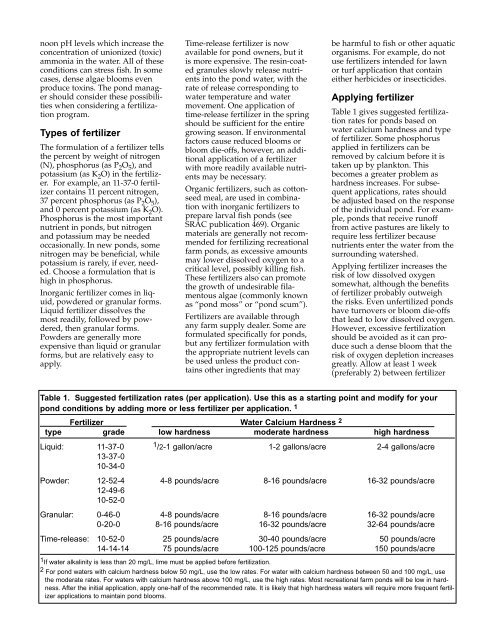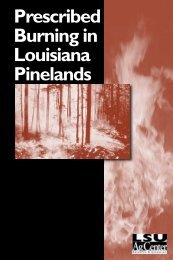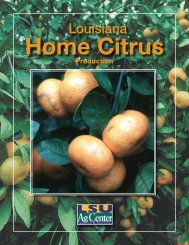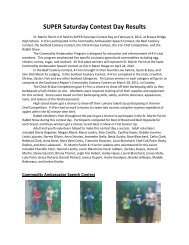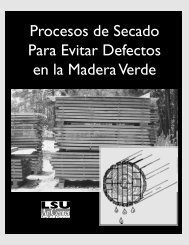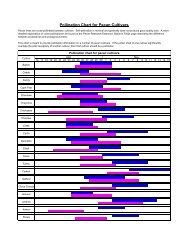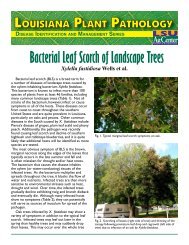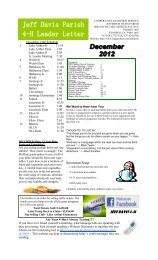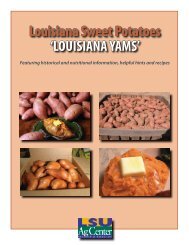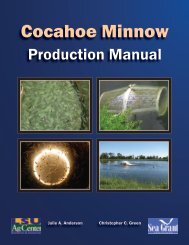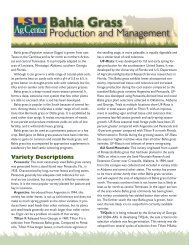SRAC 0471: Fertilization of Fish Ponds
SRAC 0471: Fertilization of Fish Ponds
SRAC 0471: Fertilization of Fish Ponds
You also want an ePaper? Increase the reach of your titles
YUMPU automatically turns print PDFs into web optimized ePapers that Google loves.
noon pH levels which increase the<br />
concentration <strong>of</strong> unionized (toxic)<br />
ammonia in the water. All <strong>of</strong> these<br />
conditions can stress fish. In some<br />
cases, dense algae blooms even<br />
produce toxins. The pond manager<br />
should consider these possibilities<br />
when considering a fertilization<br />
program.<br />
Types <strong>of</strong> fertilizer<br />
The formulation <strong>of</strong> a fertilizer tells<br />
the percent by weight <strong>of</strong> nitrogen<br />
(N), phosphorus (as P2O5 ), and<br />
potassium (as K2O) in the fertilizer.<br />
For example, an 11-37-0 fertilizer<br />
contains 11 percent nitrogen,<br />
37 percent phosphorus (as P2O5 ),<br />
and 0 percent potassium (as K2O). Phosphorus is the most important<br />
nutrient in ponds, but nitrogen<br />
and potassium may be needed<br />
occasionally. In new ponds, some<br />
nitrogen may be beneficial, while<br />
potassium is rarely, if ever, needed.<br />
Choose a formulation that is<br />
high in phosphorus.<br />
Inorganic fertilizer comes in liquid,<br />
powdered or granular forms.<br />
Liquid fertilizer dissolves the<br />
most readily, followed by powdered,<br />
then granular forms.<br />
Powders are generally more<br />
expensive than liquid or granular<br />
forms, but are relatively easy to<br />
apply.<br />
Time-release fertilizer is now<br />
available for pond owners, but it<br />
is more expensive. The resin-coated<br />
granules slowly release nutrients<br />
into the pond water, with the<br />
rate <strong>of</strong> release corresponding to<br />
water temperature and water<br />
movement. One application <strong>of</strong><br />
time-release fertilizer in the spring<br />
should be sufficient for the entire<br />
growing season. If environmental<br />
factors cause reduced blooms or<br />
bloom die-<strong>of</strong>fs, however, an additional<br />
application <strong>of</strong> a fertilizer<br />
with more readily available nutrients<br />
may be necessary.<br />
Organic fertilizers, such as cottonseed<br />
meal, are used in combination<br />
with inorganic fertilizers to<br />
prepare larval fish ponds (see<br />
<strong>SRAC</strong> publication 469). Organic<br />
materials are generally not recommended<br />
for fertilizing recreational<br />
farm ponds, as excessive amounts<br />
may lower dissolved oxygen to a<br />
critical level, possibly killing fish.<br />
These fertilizers also can promote<br />
the growth <strong>of</strong> undesirable filamentous<br />
algae (commonly known<br />
as “pond moss” or “pond scum”).<br />
Fertilizers are available through<br />
any farm supply dealer. Some are<br />
formulated specifically for ponds,<br />
but any fertilizer formulation with<br />
the appropriate nutrient levels can<br />
be used unless the product contains<br />
other ingredients that may<br />
be harmful to fish or other aquatic<br />
organisms. For example, do not<br />
use fertilizers intended for lawn<br />
or turf application that contain<br />
either herbicides or insecticides.<br />
Applying fertilizer<br />
Table 1 gives suggested fertilization<br />
rates for ponds based on<br />
water calcium hardness and type<br />
<strong>of</strong> fertilizer. Some phosphorus<br />
applied in fertilizers can be<br />
removed by calcium before it is<br />
taken up by plankton. This<br />
becomes a greater problem as<br />
hardness increases. For subsequent<br />
applications, rates should<br />
be adjusted based on the response<br />
<strong>of</strong> the individual pond. For example,<br />
ponds that receive run<strong>of</strong>f<br />
from active pastures are likely to<br />
require less fertilizer because<br />
nutrients enter the water from the<br />
surrounding watershed.<br />
Applying fertilizer increases the<br />
risk <strong>of</strong> low dissolved oxygen<br />
somewhat, although the benefits<br />
<strong>of</strong> fertilizer probably outweigh<br />
the risks. Even unfertilized ponds<br />
have turnovers or bloom die-<strong>of</strong>fs<br />
that lead to low dissolved oxygen.<br />
However, excessive fertilization<br />
should be avoided as it can produce<br />
such a dense bloom that the<br />
risk <strong>of</strong> oxygen depletion increases<br />
greatly. Allow at least 1 week<br />
(preferably 2) between fertilizer<br />
Table 1. Suggested fertilization rates (per application). Use this as a starting point and modify for your<br />
pond conditions by adding more or less fertilizer per application. 1<br />
Fertilizer Water Calcium Hardness 2<br />
type grade low hardness moderate hardness high hardness<br />
Liquid: 11-37-0<br />
13-37-0<br />
10-34-0<br />
1 /2-1 gallon/acre 1-2 gallons/acre 2-4 gallons/acre<br />
Powder: 12-52-4<br />
12-49-6<br />
10-52-0<br />
4-8 pounds/acre 8-16 pounds/acre 16-32 pounds/acre<br />
Granular: 0-46-0 4-8 pounds/acre 8-16 pounds/acre 16-32 pounds/acre<br />
0-20-0 8-16 pounds/acre 16-32 pounds/acre 32-64 pounds/acre<br />
Time-release: 10-52-0 25 pounds/acre 30-40 pounds/acre 50 pounds/acre<br />
14-14-14 75 pounds/acre 100-125 pounds/acre 150 pounds/acre<br />
1If water alkalinity is less than 20 mg/L, lime must be applied before fertilization.<br />
2 For pond waters with calcium hardness below 50 mg/L, use the low rates. For water with calcium hardness between 50 and 100 mg/L, use<br />
the moderate rates. For waters with calcium hardness above 100 mg/L, use the high rates. Most recreational farm ponds will be low in hardness.<br />
After the initial application, apply one-half <strong>of</strong> the recommended rate. It is likely that high hardness waters will require more frequent fertilizer<br />
applications to maintain pond blooms.


